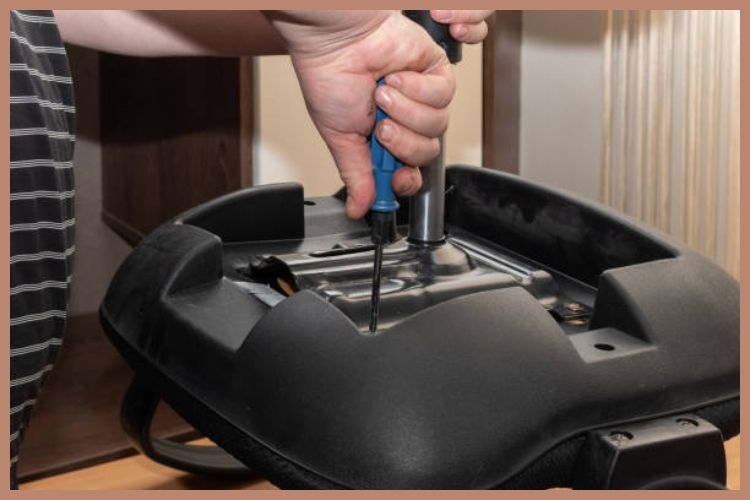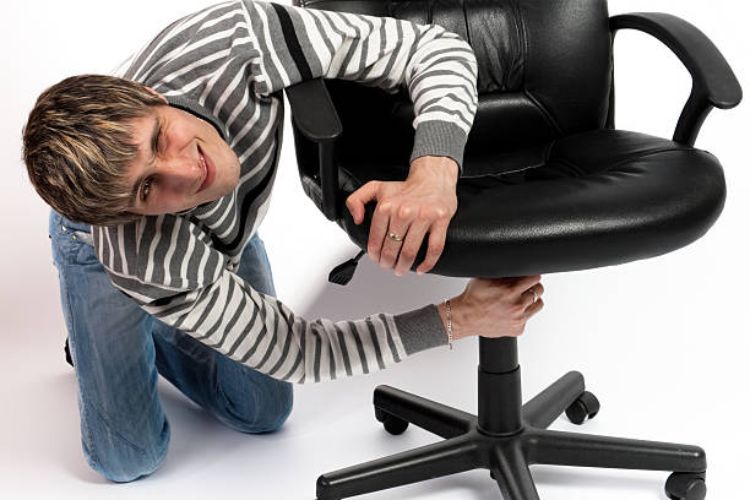Having difficulty adjusting the height of your office chair? Or does it seem to be stuck at the wrong height, office chair won’t stay up!?! Don’t worry – there are a few simple ways to fix this issue.

With just a few tools and materials like hose clamps, PVC pipes, duct tape, and metal cylinders, you can adjust your office chair or desk chair to your desired height.
How do you fix an office chair that won’t stay up?
Having difficulty adjusting the height of your office chair? Or does it seem to be stuck at the wrong height? There are a few simple ways to fix this issue.

1. Start by measuring the height of your chair to determine how much you need to add or remove. You may need to use a tape measure for this job.
2. If you want to increase the height, then you can do this by adding layers of duct tape around the cylinder at the bottom of the chair legs until it reaches your preferred height.
Note: You can also try using a strip of rubber or a Chair Saver Kit to add padding and adjust the chair’s height in just one go.
3. To lower your office chair, you will need to remove the piston mechanism inside it commonly known as the pneumatic cylinder and replace it with shorter pieces if necessary.
4. If you don’t have a removal tool, you can also use a jubilee clip to attach two PVC pipes together and then place them in the metal cylinder of the office chair.
5. Another temporary solution for adjusting your office chair’s height is to use a hose clamp around the plastic skirt that covers the bottom of your desk chair.
(This will provide some resistance when you are trying to move it up or down and will help keep it in place until you find a more permanent solution).
Office chair seat won’t stay up (How to fix)
If your office chair seat won’t stay up, follow these steps to fix it:

| 1. Check the adjustment lever: | The most common reason why an office chair seat won’t stay up is a malfunctioning adjustment lever. Check the lever, and make sure it’s engaging properly. |
| 2. Tighten the screws: | If the adjustment lever is fine, check the screws that hold the seat in place. If they’re loose, tighten them to ensure that the seat stays in the desired position. |
| 3. Check the gas cylinder: | The gas cylinder is the mechanism that controls the height adjustment of the office chair. If it’s damaged or worn out, the seat won’t stay up. To check the gas cylinder, lift the seat to its maximum height and then gently lower it. If it sinks down on its own, it’s time to replace the gas cylinder. |
| 4. Replace the gas cylinder: | If the gas cylinder is the problem, you’ll need to replace it. To do this, remove the old cylinder by turning the chair over and unscrewing it from the seat. Then, insert the new cylinder and tighten it in place. |
| 5. Lubricate the mechanism: | If the seat won’t stay up even after replacing the gas cylinder, try lubricating the mechanism. Apply a few drops of lubricant to the adjustment lever and gas cylinder to help them move smoothly. |
Office chair backrest won’t stay up (How to fix)
If your office chair backrest won’t stay up, there are several things you can do to fix it. Here are some steps you can follow:
| 1. Check the tension knob: | Most office chairs have a tension knob located underneath the seat. This knob controls the tension of the spring that holds the backrest in place. If the backrest won’t stay up, try tightening the tension knob to see if that helps. |
| 2. Adjust the recline angle: | Some office chairs have a recline lever that controls the angle of the backrest. If the backrest won’t stay up, try adjusting the recline angle to a more upright position to see if that helps. |
| 3. Check the locking mechanism: | If your office chair has a locking mechanism, check to see if it’s working properly. Sometimes the locking mechanism can become worn or damaged over time, which can cause the backrest to slip. |
| 4. Tighten screws and bolts: | Check to see if any screws or bolts on the chair are loose. If so, tighten them to see if that helps. |
| 5. Lubricate moving parts: | If the chair has been used for a long time, the moving parts may have become stiff or sticky. Try lubricating the joints and hinges with a silicone-based lubricant to see if that helps. |
Hydraulic office chair won’t stay up (How to fix)
If your hydraulic office chair won’t stay up, here are some steps to fix it:

| 1. Check the chair’s adjustment lever: | Make sure that the chair’s adjustment lever is engaged and locked in place. If it’s not, the chair won’t stay up. |
| 2. Tighten the adjustment knob: | Another reason why the chair won’t stay up is that the adjustment knob may be loose. To fix this, locate the adjustment knob, which is usually located under the seat, and tighten it clockwise. |
| 3. Check the hydraulic cylinder: | The hydraulic cylinder is the mechanism that raises and lowers the chair. Check if there is any oil leakage or damage to the cylinder. If there is, you may need to replace the cylinder. |
| 4. Remove the cylinder: | If the hydraulic cylinder is damaged or leaking, you will need to remove it. To do this, turn the chair upside down and use a pipe wrench to loosen the bolts that hold the cylinder in place. Then, remove the cylinder from the chair. |
| 5. Replace the cylinder: | Purchase a new hydraulic cylinder that matches the specifications of your chair. Insert the new cylinder into the chair and tighten the bolts with a pipe wrench. |
| 6. Test the chair: | Once you have replaced the cylinder, test the chair to ensure that it is now staying up. If it’s still not staying up, repeat the above steps or consider contacting a professional for assistance. |
New office chair won’t go up or down
If your new office chair won’t go up or down. Then there are some possible solutions you can look at.
1. Check if the chair has a lever or button that controls the height adjustment.
(Make sure it is not stuck or obstructed and try pressing or pulling it again).
2. Check if the gas cylinder that powers the height adjustment is functioning properly.
(Look for signs of leakage, corrosion, or damage around the cylinder or the base of the chair. If you notice any of these issues, replace the cylinder or the whole chair if it is beyond repair).
3. Check if there is any debris or dust trapped in the mechanism that connects the seat to the gas cylinder.
(Tilt the chair over and inspect the underside of the seat for any visible blockages. Use a soft-bristled brush or a vacuum cleaner to remove any dirt or hair that might be clogging the mechanism).
4. Check if the height adjustment mechanism is properly assembled and aligned.
(Sometimes, the parts inside the chair can get misaligned or disconnected, preventing the chair from moving up or down. Consult the user manual or the manufacturer’s website for instructions on how to disassemble and reassemble the chair’s mechanism).

Recommendation: If you are not confident in your ability to do this, seek professional help from a furniture repair service.
How to get office chair to stay up?
To get an office chair to go up, follow these steps:
1. Locate the lever or button underneath the seat of the chair. This is usually on the right side and may be covered by a plastic or metal cover.
2. Pull the lever or press the button to release the gas cylinder in the chair.
3. While holding the lever or button, lift the seat of the chair to the desired height.
4. Release the lever or button and the gas cylinder will lock in place, keeping the chair at the desired height.
5. Test the chair by sitting in it to ensure that it is at the correct height and that it is stable.
Note: If the chair is not stable or is too high or low, repeat the process until the desired height is achieved.
How to get office chair to go down?
To lower an office chair, follow these steps:
1. Locate the lever or knob that controls the height adjustment of the chair.
2. If the chair has a lever, pull it up while applying weight to the chair to lower it.
3. If the chair has a knob, turn it counterclockwise to release the lock and lower the chair to the desired height.
4. Make sure to test the chair’s stability after adjusting the height to ensure that it is secure and safe to use.
5. If the chair still does not go down, check if there is anything obstructing the mechanism or if it needs to be lubricated.
How to use office chairs properly?
Using office chairs properly is essential to maintaining good posture and avoiding discomfort or injury. Here are some tips on how to use office chairs properly:

| 1 | Adjust the chair height so that your feet are flat on the ground and your knees are at a 90-degree angle. |
| 2 | Adjust the backrest so that it supports the natural curve of your spine. |
| 3 | Keep your shoulders relaxed and avoid hunching forward or leaning back too far. |
| 4 | Use armrests to support your arms and avoid tension in your neck and shoulders. |
| 5 | Take breaks and stretch regularly to avoid stiffness or strain. |
| 6 | Avoid sitting for long periods of time and try to alternate between sitting and standing throughout the day. |
| 7 | Use a footrest if necessary to keep your feet flat on the ground and avoid pressure on the back of your thighs. |
| 8 | Use a lumbar pillow or support if necessary to maintain proper spinal alignment. |
| 9 | Make sure the chair is stable and does not wobble or rock. |
| 10 | Choose a chair with adjustable features to customize it to your body and needs. |
Conclusion.
If your office chair won’t stay up, it’s likely due to a malfunctioning gas cylinder. It’s important to address this issue promptly to avoid discomfort and potential injury. Seeking a professional repair or replacement is recommended for optimal office ergonomics and productivity. You can also follow our steps to recover your office chair nicely.
FAQs
Frequently Asked Questions
How to fix office chair tilt?
To fix the office chair tilt, you will need to adjust the tension knob or lever located underneath the seat. Turn the knob or adjust the lever until you feel the desired level of tilt. If the chair still tilts too much or not enough, you may need to check for any loose screws or broken parts and replace them accordingly.
How to assemble office chair with headrest?
To assemble an office chair with a headrest, start by laying out all the parts in front of you and identifying each one. Next, attach the wheels to the base of the chair and then attach the gas lift mechanism to the center of the base. Then, attach the seat to the gas lift mechanism and screw in the armrests on either side of the seat. Finally, attach the headrest to the top of the chair back and adjust it to your desired height.
How to fix office chair leaning forward?
To fix an office chair leaning forward, first, check if the gas lift cylinder is functioning correctly. If not, you may need to replace it. If the cylinder is fine, adjust the tilt tension knob under the seat to tighten or loosen the backrest’s backward tilt. Adjust the backrest angle to your desired position and tighten any loose screws or bolts.



Leave a Reply